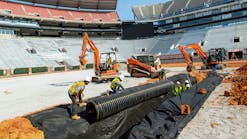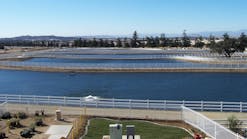Retain, Detain
About the author: Gina Carolan is chief operating officer and director of marketing for Cultec Inc. Carolan can be reached at [email protected].
Grangegorman is a suburb on the north side of Dublin, approximately 1 mile from the city center. Though diverse in terms of architectural, historical and land use character, the area is fragmented and separated from surrounding residential neighborhoods, limiting expansion opportunities and discouraging the overall development of the area. At almost 73 acres, Grangegorman was the largest undeveloped site in Dublin.
In 2006, the Grangegorman Development Agency (GDA) was established by the Irish government under the Grangegorman Development Agency Act 2005 to revitalize the site. The GDA is working to create a vibrant new city quarter with a diverse mix of uses, including health, education and community aspects, while opening up a previously walled-off part of the city. Construction on the multi-phase project began in 2013 and ultimately will include:
- A high-quality area with physical linkages to Smithfield, Phibsborough, Prussia Street and the City Centre;
- New health care facilities for the Health Services Executive, including a separate center for mental health, primary and elderly care;
- A new urban campus for the Dublin Institute of Technology, bringing students and staff into one location;
- New arts, cultural, recreational and public spaces to serve the community and city;
- A complementary mixed-usedevelopment; and
- A primary school, public library and children’s play spaces.
Grangegorman’s Storm Water
The development in Grangegorman is an extensive inner-city rejuvenation project that requires the creation of multiple concrete surfaces. This will direct large amounts of water along impervious surfaces, so it will be unable to filter into the ground. Traditionally, a portion of this runoff was captured by a network of large pipe systems and later disposed of, without treatment, into a nearby river.
Cloudburst, a sustainable water management systems company that designs, installs and supports storm water, floodwater and rainwater technologies, was brought in to specify sustainable drainage solutions to meet the expected needs of the project. Along with the main contractor, Ballysheed, Ireland-based Roadbridge, and Dublin-based design engineers ARUPS and O’Connor Sutton Cronin, Cloudburst delivered one of the largest infiltration systems in Dublin to date.
“In accordance with best practices developed due to climate changes and the implementation of the European Union [EU] Water Framework Directive, it is now mandatory to manage storm water disposal in a more environmentally friendly way,” said David Newman, who, at the time of the project, was technical director for Cloudburst. “Because large impervious surfaces commonly lead to multiple impacts on stream systems—including higher peak stream flows, reduction of infiltration and increases in pollutant loads to local water bodies—Cloudburst advised on the positive environmental impact of the proposed storm water chambers in addition to the engineering design of the system.”
Challenges & Opportunities
One particular challenge the design team faced was tying the new subsurface storm water system into the existing drainage invert levels.
The design team chose a Cultec Inc. subsurface storm water management system for a combination of storm water retention and detention. It was chosen because the chambers feature high removal rates for phosphorous, nitrogen, lead, zinc, suspended solids and organic carbon. The underground system disposes of all storm water on site through infiltration and allows the runoff to help replenish the natural water table, as it would have naturally before the site was developed.
The Grangegorman site required 84,755 cu ft of storage, prompting the Cloudburst team to use Cultec Recharger 330XLHD chambers. This model has a capacity of more than 400 gal, making it one of the largest options available. The unit is 52 in. wide by 30.5 in. high and has an installed length of 7.5 ft with a bare chamber capacity of 7.5 cu ft. Due to its size, the chamber can help save land space and offers design flexibility. In all, the subsurface system provided 84,917 cu ft of storage in a minimal footprint, satisfying the requirements of the site.
Members of Roadbridge Construction, assisted by Cloudburst and Cultec, installed the subsurface system, which included a total of 598 Recharger 330XLHD chambers arranged in 26 rows beneath a set of grass tennis courts. Additionally, No. 410 filter fabric encases the entire bed to prevent soil intrusion into the chamber bed.
“Roadbridge worked side by side with Cloudburst and O’Connor Sutton Cronin to design an attenuation solution for Grangegorman that had the minimum environmental impact during installation, but also delivered the most positive environmental attenuation process,” said Gary Doyle, commercial manager for Roadbridge. “This solution was designed in accordance with best practices and in alignment with the EU Water Framework Directive. [Sustainable drainage systems] specialists Cloudburst recommended the Cultec Contactor and Recharger storm water chambers, which proved to be the highest-quality system and also highly cost-effective. Installation was fast and efficient and we are delighted with the finished system.”
The chambers are dome shaped, with perforated sidewalls and fully open bottoms to allow maximum infiltration. In addition, 25 HVLV FC-24 feed connectors were inserted into the side portals of the chambers to create an internal manifold system. The feed connectors have a larger flow capacity than a 12-in.-diameter pipe. Coupled with the plastic storm water chambers, the manifold created an underground detention field that will hold water until it can be cast out.
“A key benefit of using the Cultec chambers is that, over time, a natural biomass will form on the walls and floor and the geotextile membrane, which filters and helps to break down micropollutants and other contaminants that may be in the storm water,” Newman said. “The chambers carry substantial point ratings under the LEED and [Building Research Establishment Environmental Assessment Methodology] programs, making them of considerable benefit to clients and society as a whole.”
The storm water management system was designed and installed in accordance with the Greater Dublin Urban Drainage Directive, Department of Environment Regulation, European Community Directives, and Dublin building and health and safety regulations.
Download: Here







